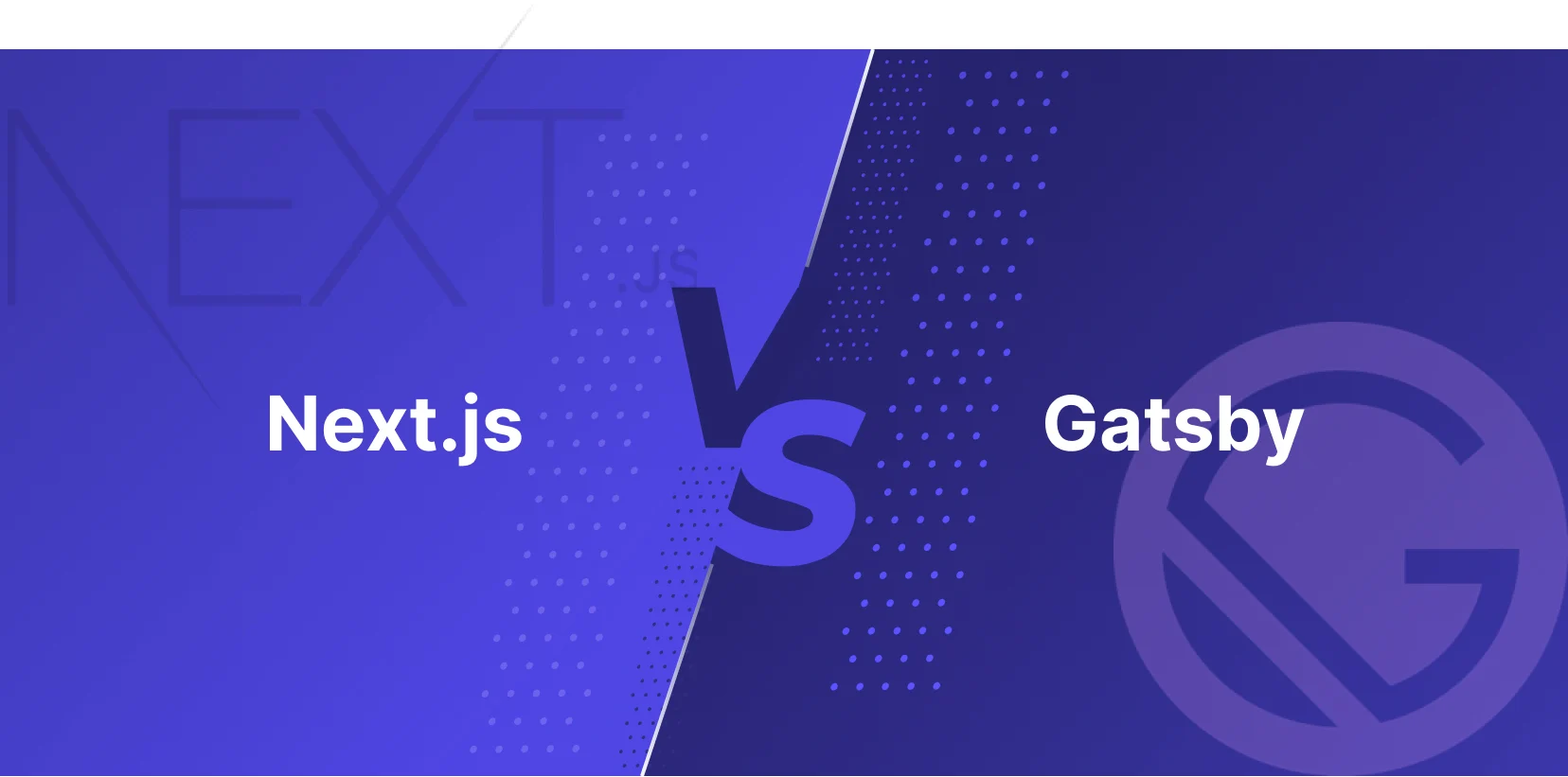- JAMstack
Next.js vs. Gatsby: The Difference and Which Framework to Choose


When choosing a static site generator, two of the most popular options are Next.js and Gatsby. Each tool has its own set of advantages and disadvantages, so it's important to choose the one that best fits your project's needs.
Next.js is a React-based framework that offers server-side rendering and dynamic routing. This makes it ideal for applications that require complex data fetching or user authentication.
Gatsby, on the other hand, is built on top of React and GraphQL. It uses static site generation to pre-build pages, which makes it faster and more lightweight than Next.js. However, this means that Gatsby is less suited for applications that need to fetch data in real-time.
When deciding between Next.js and Gatsby, it's important to consider the specific requirements of your project in order to make an informed decision.
Next.js
What Is Next.js?
Next.js is a JavaScript framework that helps developers create server-rendered or statically exported React applications. It provides a set of tools to develop websites and web applications. With Next.js, developers can create dynamic webpage content while still accessing all the benefits of a statically generated site.
Additionally, Next.js provides features such as extensible routing, code splitting, and automatic prefetching of resources, making it an excellent choice for building performant web applications.
Overall, Next.js is a powerful tool that can help developers create fast, modern websites and web applications.
Features of Next.js
Hot Reload: You can quickly see changes made to your application without needing to reload the page.
Automatic Routing: Every file included in the "pages" directory automatically becomes a route, so there's no need for any extra setup for routing.
Code Splitting: Pages are rendered based on the libraries that they need, and only the required amount of JavaScript functions to run that page are loaded.
Prefetching: Using
<Link>helps Next.js fetch all of the necessary JavaScript before the page is rendered, improving performance.
Advantages of Next.js
Built-In CSS Support:
You can easily import CSS files from Javascript.
Fast Refresh: You can view changes without reloading the page.
Incremental Static Generation: By rendering websites in the background as traffic arrives, it enables developers to update already existing pages. In this way, static content can become dynamic.
Zero-Config: Instead of concentrating on the application logic of your Next.js app, Next enables you to focus on it. Additionally, it offers automatic compilation and packing to aid you. In other words, Next is designed to be productive from the beginning.
Faster Time to Market: Building an MVP is considerably faster with Next because many ready-to-use components are available. This way, you can immediately collect feedback from actual customers and make the necessary improvements to your product without wasting time or money.
Data Security: Next.js static websites do not have a direct connection with databases, making it difficult for hackers to attack.
Disadvantages of Next.js
When it comes to the disadvantages of using Next.js, there are a few key points to consider. Firstly, there are fewer plugins available for Next.js compared to Gatsby. While Gatsby has a vast library of plugins that can be used to add extra features to an application, Next.js has a more limited selection. This means that if you need a specific feature that is not available in Next.js, you may need to develop it yourself or find a third-party solution.
Another disadvantage of using Next.js is the lack of built-in state management. To manage the state in a Next.js application, you will need to use external state managers such as MobX or Redux. While these tools are powerful and flexible, they do require additional setup and configuration, which can add to the complexity of your application.
Finally, it's worth noting that Next.js requires a dedicated in-house developer to manage the application if you don't already have one. This is because Next.js is a complex framework that requires a certain level of expertise to use effectively. If you don't have a developer on staff who is familiar with Next.js, you may need to hire one or outsource the development work.
Overall, while Next.js is a powerful and flexible framework, it does have a few key disadvantages that need to be considered when deciding whether to use it for your project. By weighing the pros and cons carefully and considering your specific needs, you can make an informed decision about whether Next.js is the right choice for you.
Gatsby
What Is Gatsby?
Gatsby is a static site generator based on React. It creates rich and effective websites and applications using contemporary web technologies such as Webpack and GraphQL.
Static site generators like Gatsby are becoming more popular because of their many benefits over static websites built using a standard dynamic CMS. They are ideal for the modern web because they are typically faster and more secure and can be deployed to any host or platform. If you're looking for a static site generator that is quick, secure, and easy to use, Gatsby is an excellent alternative.
Features of Gatsby
Based on React
One of Gatsby's greatest strengths is that, as a React-based framework, it has a simple learning curve and is easy enough for developers of all skill levels to adopt. If you can build it with React, you can create it with Gatsby, whether you're constructing an e-commerce site, a blog, or a corporate website.
Load Data from Anywhere
Gatsby eliminates the hassle of manual integration and provides developers with access to best-in-class services while maintaining the workflows of content producers. This way, you can easily manage a variety of data sources and link third-party services.
Performance
Gatsby's build process is optimized to achieve the highest level of site speed through the use of various techniques. These include inclining crucial assets, efficient code splitting, and resource prefetching.
Code splitting ensures that only the necessary code is sent for each page, improving speed and performance. Gatsby also uses slow loading and intensive image optimization to load even rich images quickly and provide a seamless experience.
By cleverly pre-loading assets, Gatsby further improves site performance and navigation experience for consumers.
Low Hosting Cost
Because Gatsby sites don't require servers, you can host your website on a content delivery network (CDN) for very little cost or even for free on Gatsby Cloud. Gatsby produces static content instead of server-rendered websites, which is simple and inexpensive to host with any provider.
Open Source Ecosystem
Gatsby is open-source and has a large community of contributors creating plugins to improve Gatsby applications. The Gatsby community has produced more than 2000 plugins, so it's likely that the features you want to include on your website already exist as pre-made tools that you can quickly and easily incorporate.
Advantages of Gatsby
Modern Workflow
GatsbyJS adheres to the most recent web standards and technologies, such as React, GraphQL, and Webpack. As a result, GatsbyJS developers can take advantage of the best aspects of React and GraphQL.
Out-of-the-Box Performance
Websites and applications powered by Gatsby are fast by default, so developers do not need to add extra plugins or extensions.
Active Community
As Gatsby's popularity continues to grow, so does its community. It's possible that someone within the community may be able to assist you in resolving any issues you encounter.
Multiple Data Sources
With Gatsby, you can access any number of different data files locally or retrieve information from remote websites such as Medium, WordPress, and more. In other words, you can access information from any source that has an API.
Disadvantages of Gatsby
Low-Quality Plugins
One of Gatsby's greatest strengths is its ecosystem, which also means that creating Gatsby sites often requires switching between various GitHub repositories. This is because everything you need has been created and is still being updated by others. However, this also makes it difficult to determine whether the plugin you are using actually functions as intended.
Trickey Troubleshooting
Gatsby includes a great deal of preset functionality that works like magic and saves developers plenty of time. However, due to the high level of default configurations and underlying tools, troubleshooting can be tricky when something goes wrong.
Build Time
Administrative users expect to see changes reflected immediately on the website after saving changes in the content management system. However, due to the way Gatsby pre-renders assets, there is typically a 1 to 3-minute delay before changes become visible.
Gatsby vs. Next: Head-to-Head Comparison
Two of the most popular frameworks for creating static and server-rendered React applications are Gatsby and Next.js.
Each has its advantages and disadvantages, so which is the best for your project?
Performance is always crucial when selecting a framework, and both Gatsby and Next.js are renowned for being fast. Gatsby has the advantage, however, due to its use of static rendering. Pages are pre-rendered at build time, resulting in significant performance improvements. Next.js, on the other hand, uses a more traditional server-side rendering approach, which can be slower but offers greater flexibility.
Both Gatsby and Next.js offer a wealth of features right out of the box. Gatsby, however, excels in its ecosystem of plugins. There are thousands of Gatsby plugins available that can enhance its functionality in various ways. In contrast, Next.js provides a limited selection of plugins. This means that Next.js may not be ideal for projects that require extensive customization, although this is not always a disadvantage.
Scalability is another important consideration, and both Gatsby and Next.js are capable of handling complex projects. However, Gatsby approaches scaling a little differently than Next.js. With Next.js' server-side rendering, you can easily scale up your application by adding more servers. In contrast, Gatsby creates static assets that can be put on a CDN. Compared to Next.js, Gatsby requires less infrastructure for scalability.
Finally, we must consider the learning curve. Familiarity with React is required for both Gatsby and Next.js. However, the use of GraphQL in Gatsby can make it slightly more challenging to master than Next.js. Having said that, Gatsby is a powerful toolkit that allows you to create amazing things with relatively little code once you've become proficient with it.
When to Use Next.js Over Gatsby?
Both of these tools can help you create fast, reliable, and modern web applications. However, the choice of whether to use Next or Gatsby depends on your specific needs and preferences. Here are some key considerations to keep in mind:
Next is a great choice if you want to use server-side rendering. This means that your app will load faster and be more responsive since the server will do most of the work instead of the client.
If you plan on using a lot of JavaScript, Next may be a better option because it uses Babel to compile your code. This means you can use newer JavaScript features without worrying about compatibility issues.
Gatsby is generally considered to be more opinionated than Next, which means that it's easier to get started with Gatsby since everything is already set up for you. However, it also means that you may have less flexibility when it comes to customization.
Ultimately, whichever framework you choose, you'll be able to build amazing web applications!
Intended Use Cases for Next.js
Next.js is a highly capable framework for building applications that require scalability. With its server-side rendering techniques, Next.js is especially useful for big applications that frequently change data throughout the day. This can be beneficial for enterprises that require real-time data updates and demand a high level of responsiveness from their applications.
For instance, Netflix, Twitch, and Github are just a few examples of companies that place their trust in Next.js for handling their ever-changing applications. These companies have large user bases and have to deal with vast amounts of data on a daily basis. Next.js' ability to handle such high traffic and scaling requirements makes it an ideal choice for them. Moreover, the framework's flexibility and ease of use make it a popular choice among developers who seek to build sophisticated and scalable applications with minimal effort.
When to Use Gatsby over Next.js?
In general, Gatsby is an excellent choice for building fast, dynamic websites or applications. However, Next.js may be a better fit in certain scenarios. Here are some factors to consider when making your decision:
Gatsby is built on top of React. If you're already familiar with React, it will be easier to get started with Gatsby. On the other hand, Next.js supports both React and Vue. If you're more comfortable with Vue, you might want to use Next.js.
Gatsby has a wider range of plugins and resources available. Thus, it's generally easier to find what you need. With Next.js, you may need to do more searching for plugins and resources since it doesn't have as large a community yet.
Gatsby sites tend to be faster than Next.js sites. However, this difference may not be noticeable unless your site is particularly large or complex.
Ultimately, the decision of which SSG to use comes down to personal preference and the specific needs of your project. You should consider questions like "Will my application be very dynamic?" and "How large is it going to be?" when making your choice.
Intended Use Cases for Gatsby
Gatsby is a static site generator that is commonly used for building smaller applications, such as personal blogs and landing pages. However, even though it may be less ideal for larger web pages over 100k, there are still ways to optimize Gatsby for these types of projects. For instance, you could break up the site into smaller components or utilize dynamic imports to keep the site from becoming too bloated. Additionally, Gatsby's plugin ecosystem is constantly expanding, which means there are always new ways to enhance the functionality of your site. So, while Gatsby may be best suited for smaller projects, with the right approach, it can still be a viable option for larger endeavors.
The Bottom Line: Which One to Choose When
Both frameworks, Gatsby and Next.js, are excellent tools for building production-ready applications. They offer features such as hot reloading, code splitting, and route prefetching, providing an exceptional developer experience. However, which one you should choose depends on your specific needs.
If you need a quick website that can be easily expanded with plugins, Gatsby is a fantastic option. On the other hand, if you require a scalable website that can be installed in a serverless environment, Next.js is a suitable option.
Ultimately, the choice depends on your project requirements.
Is Next.js Better than Gatsby?
Both frameworks are based on React, a JavaScript library for building user interfaces. However, there are some key differences between the two frameworks.
Gatsby is a static site generator, which means that it generates a static HTML file for each page on your website. This makes Gatsby's websites extremely fast, but it also means that they cannot be dynamically updated without redeploying the entire site.
Next, on the other hand, is a dynamic framework that generates a new HTML file for each page request. This makes Next websites slower than Gatsby websites, but it also means that they can be dynamically updated without redeploying the entire site.
So, if speed is your top priority, Gatsby is the better choice. If dynamic updates are more important to you, then Next is the better choice.
Download the best JavaScript frameworks guide to answer the 'which JavaScript framework to use for your next project?'

